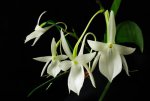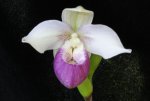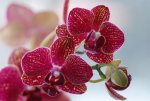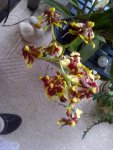Ok, but I caution you...orchids can be as addicting as ponds! Don't say I didn't warn you!
I got my first orchid when I was in the hospital in 2005. Killed it. Then a Costco orchid. Killed it. Repeat several times until 2009 when we were remodeling the new house. During one of my many trips to Home Depot, I saw a book...Miracle Gro's Guide to Growing Orchids. Within an hour of reading, I had a really good idea of what I had been doing wrong.
The key to growing orchids is knowing what their native growing environment is like. For example, a lot of phalaenopsis hybrids have the species amabilis in them. Amabilis is native to Malaysia, the Philippines and Australia, often attached high in trees in dense forest. They are not parasitic; they take no nutrients from the trees, but are simply attached by their roots in places where they receive dappled light, get regular rain on their roots, but then dry out between rainfalls.
Translated to hobby growing, they like bright but not direct sunlight, enjoy temperatures similar to in our homes, and the roots get water but then air dry. Ideally, we would all grow them mounted on things like cork bark, but realistically for a home grower, it is impractical to water orchids every day. So we put them in pots---to suit us, not them---which is where the difficulty comes in. I think most orchids like phals are probably killed by overwatering in a medium that does not allow the roots to get air, rather than by underwatering.
So the trick is watering them enough (like a good soak in a bowl of water for 20 minutes or so), then allowing them to almost dry out before watering them again. And the really BIG trick is knowing how your medium is drying in the pot. Moss, like sphagnum moss (lots of phals are planted in this, especially for big box stores) can be packed way too tight (remember the roots like air) and stay wet too long before drying out, which leads to the roots rotting.
I use a mix of ground coconut (called coir), charcoal and perlite as my medium for phals. I like it because it gives the roots a steady supply of water to the roots, but is "airy" and lets the roots breathe, so to speak. When the medium has just been watered, it's the color of dark chocolate. When it looks like milk chocolate, it's time to water again.
Not everyone likes this, or do their conditions make this the best mixture for their orchids (and I only use it for phals...other orchids have different mixes according to their needs.)
As for "tickling the roots", lol, that is funny, I have not heard that before. I suppose a good repotting would do the tickling! As for the "tight shoes" idea. Orchids don't grow in tight pots in nature, and in the home they don't grow any better in a tight pot than a larger one, except for this important point. Larger pots dry less quickly, and that can result in root rot. In the case of phals, it is a diurnal temperature drop of 10-15° for a few weeks that generally initiates spiking (as long as the season is right.)
This is a very long-winded answer to your questions. I love talking orchids, so if you have more questions, fire away.
Oh, and what was really my downfall...I joined orchidgeeks.com. A friendly international forum of orchid geeks who are oh too willing to post tempting photos of orchids you've never heard of but suddenly can't live without! Enter at your own risk!
Some of my babies








